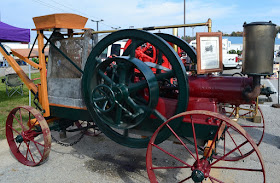In the early years of the 20th century International Harvester, like many of their competitors, sought to produce a full line of agricultural tools and equipment with the goal of providing the farmer with a device for every need. A look through a catalog of the period reveals that by and large they succeeded. With an array of labor saving machines offered it was only natural to produce a power source to run them. To fill this market niche they produced internal combustion engines ranging from 1 to 25 hp.
This beautifully restored example was displayed at the 2015 WNC Fall Harvest Days Antique Engine and Tractor Show sponsored by Apple Country Engine & Tractor Association. www.applecountry.org As is often the case at these shows, not a lot of information was provided. This framed photocopy of a page from a catalog was all that was offered and it didn't even give the date of manufacture which made learning more about it somewhat difficult.
The data plate on the engine offered that it was a portable engine by IHC of Chicago. Serial number EF421E producing 10hp at 350 rpm. The framed page from a catalog states that these engines were ideal for running huskers, shredders, threshers, shellers, pumping,well drilling,stone crushing and generating electricity for electric lighting. In short, pretty much any device you could power with a belt.
Visits to a number of websites turned up information on International portable engines but nothing that would definatively identify this particular engine. The closest match I found was at www.vintagemachinery.org/pubs/2796/5964.pdf with an illustration for a Titan tank cooled10 hp @ 350 rpm engine from 1913. If you know of a site that provides a listing of serial numbers for these engines please leave a comment.
The thing that caught my eye about this engine was the evaporative cooling system with water from the engine being dribbled across a screen before running down to the collecting tank. Company literature of the period refers to it as tank cooled which I found somewhat misleading since that suggested something more like an open hopper to me.
I wonder if the brass bright work is original equipment or a later embellishment? Most likely original since that was the way they built things back in the day.






No comments:
Post a Comment
Leave a comment or send an email to: stevedritch@gmail.com